|
|
By Sandy, on May 19th, 2009
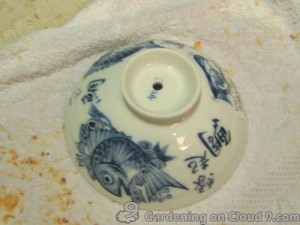 We know that good drainage is the key to healthy plants, but the containers that we find most attractive are often the ones without drainage holes. But we can drill the drainage holes by ourselves, and it is much easier than what most of us would expect. All we need is an electric drill and steady hands. We know that good drainage is the key to healthy plants, but the containers that we find most attractive are often the ones without drainage holes. But we can drill the drainage holes by ourselves, and it is much easier than what most of us would expect. All we need is an electric drill and steady hands.
And here, let me show you how to drill holes on our containers.
Continue reading Drilling Drainage Holes by Ourselves
By Sandy, on May 12th, 2009
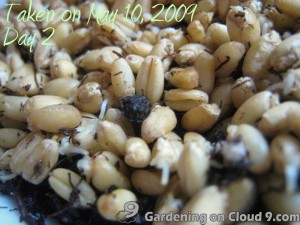
Last morning, I found some cat grass seeds had started germinating.
Continue reading Cat Grass Day 3 – I See Some Greens!
By Sandy, on May 10th, 2009
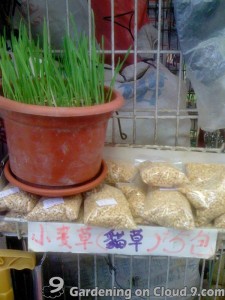 I have heard of cat grass in a gardening forum before. Yet, since I have no cat at home, I have never given much thought about growing it, but only until recently, when I am planning to make a tabletop container garden for a friend who is a cat lover. I have heard of cat grass in a gardening forum before. Yet, since I have no cat at home, I have never given much thought about growing it, but only until recently, when I am planning to make a tabletop container garden for a friend who is a cat lover.
So, a few days ago, I went to the flower market hoping to find some cat grass. And with my luck, I found a store that sold cat grass seeds.
Continue reading Cat Grass Day 1 – It Sounds Too Good to Be True!
By Sandy, on May 4th, 2009
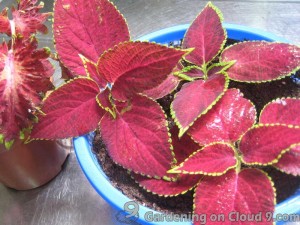 It is quite easy to do cutting propagation for coleus. Last month, I took four cuttings from my coleuses, and three of them have survived. I guess this wasn’t too bad for someone who propagated plant from cutting for the first time, and I have already started propagating my second batch of coleus cuttings a few days ago. It is quite easy to do cutting propagation for coleus. Last month, I took four cuttings from my coleuses, and three of them have survived. I guess this wasn’t too bad for someone who propagated plant from cutting for the first time, and I have already started propagating my second batch of coleus cuttings a few days ago.
So here, let me show you how I do cutting propagation with my coleus.
Continue reading Plant Propagation from Cuttings – Coleus
By Sandy, on April 18th, 2009
While we are familiar with the common names of our houseplants, most of us do not know the botanical name of our plants. This is totally fine, for it is absolutely not necessary to memorize those long, daunting botanical names. We can just use the botanical names for reference when looking up information of our plants in guidebooks or websites. Here are the reasons why we use botanical names for plant identification.
Botanical Name of a Plant – The Breakdown
The botanical name of a plant is composed of two major parts, the genus and the species of the plant. For simplicity’s sake, genus is the family and species is a member of the family.
Continue reading Botanical Name – What is in the name?
By Sandy, on April 18th, 2009
While common name is so much easier for us to use, there are several good reasons for us to use botanical names for plant identification.
Botanical Name – Unique to Only One Plant
Every plant has at least one unique botanical name (or scientific name or Latin name) to it. This means that every botanical name refers to one and only one plant. Some plants may have more than one botanical name, yet this is not very common. To avoid confusion, it is better to use botanical name for plant identification.
Continue reading Why Do We Use Botanical Names?
By Sandy, on April 12th, 2009
When we pot our plant for the first time after getting it from a garden nursery, or repot our houseplant when it has outgrown its container, we have to choose a new container with the right size for our plant.
Using Garden Containers Too Big
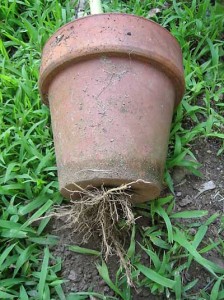 When a houseplant gets too large for its container, its roots will start circling around inside the container, and restricting themselves. If our houseplants appear to dry out more quickly than they used to, but are otherwise healthy, the plants are probably pot bound. Continue reading Containers for Houseplants – Size Matters! When a houseplant gets too large for its container, its roots will start circling around inside the container, and restricting themselves. If our houseplants appear to dry out more quickly than they used to, but are otherwise healthy, the plants are probably pot bound. Continue reading Containers for Houseplants – Size Matters!
By Sandy, on April 10th, 2009
Ok! Here is a lesson that I have learned recently – Don’t try to save ourselves some work by planting our houseplant in a container too large, for we could damage or even kill our plants!
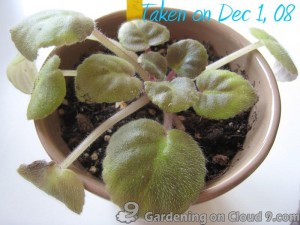 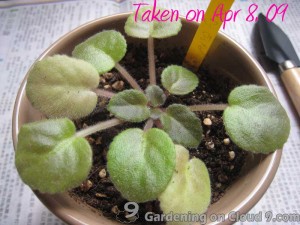
Continue reading My African Violet Doesn’t Like Its Big House
By Sandy, on April 8th, 2009
Besides sunlight, nothing can be more valuable to an indoor gardener than her garden journal. A record of your plants’ details, such as the purchasing dates of your plants, the dates when your plants bloom or mature, the sizes, the colors, and all other information you have found about your plants, is an essential resource of your gardening experience. Your gardening journal will help you answer questions about what your plant may need if it starts looking poorly, and will remind you of what works and what doesn’t.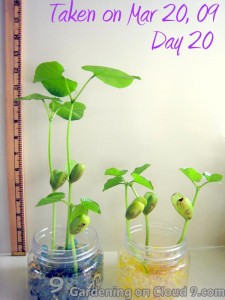
Take Photos
A picture is worth a thousand words. Instead of describing how distorted the shape of my echeveria has become, or how well (or bad) my African violet is growing, I record all these simply by taking photos of my plants every once a while. Continue reading Keeping a Garden Journal
By Sandy, on April 6th, 2009
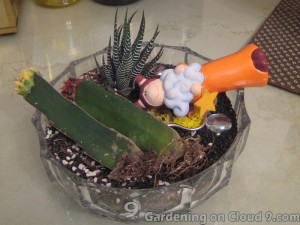 A few weeks ago, my father knocked down the two cacti in my tabletop garden – My Star when he was rushing to the windows to save the carpet and furniture from getting wet by a sudden rain. A few weeks ago, my father knocked down the two cacti in my tabletop garden – My Star when he was rushing to the windows to save the carpet and furniture from getting wet by a sudden rain.
Actually I should have anticipated this… After playing and observing this tabletop garden for a while, I have found its design deficiency – weak support. The red and yellow cacti were very tall, yet, lack of strong support. There were neither plants nor rocks to provide the cacti with enough support.
Continue reading My Star Got Crashed
|
|
 We know that good drainage is the key to healthy plants, but the containers that we find most attractive are often the ones without drainage holes. But we can drill the drainage holes by ourselves, and it is much easier than what most of us would expect. All we need is an electric drill and steady hands.
We know that good drainage is the key to healthy plants, but the containers that we find most attractive are often the ones without drainage holes. But we can drill the drainage holes by ourselves, and it is much easier than what most of us would expect. All we need is an electric drill and steady hands.


 When a houseplant gets too large for its container, its roots will start circling around inside the container, and restricting themselves. If our houseplants appear to dry out more quickly than they used to, but are otherwise healthy, the plants are probably pot bound.
When a houseplant gets too large for its container, its roots will start circling around inside the container, and restricting themselves. If our houseplants appear to dry out more quickly than they used to, but are otherwise healthy, the plants are probably pot bound. 






Recent Comments